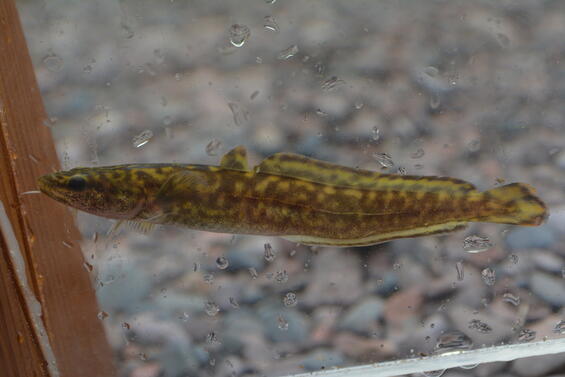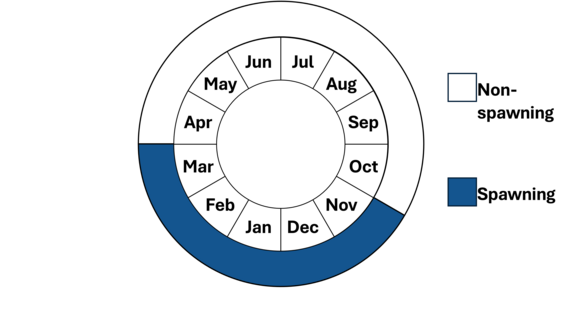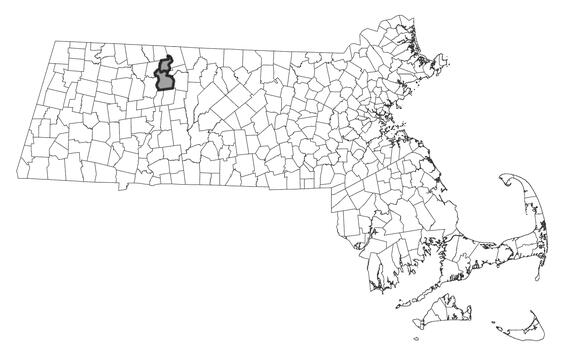- Scientific name: Lota lota
- Species of Greatest Conservation Need (MA State Wildlife Action Plan)
- Special Concern (MA Endangered Species Act)
Description

Burbot (Lota lota)
Burbot are a freshwater cod species that has an elongate body and a single, noticeable, chin barbel. They have two dorsal fins. The second dorsal fin and the anal fin are elongate and end at the caudal peduncle. No other inland fish species in Massachusetts looks like this fish.
Life cycle and behavior

Burbot can live up to 10 to 15 years. They mature when they are 3 or 4 years old and at a size of 280-480 mm (~11-19 in) in length. They are nocturnal and spawn in midwinter under the ice, from November to May, but generally January through March. This species is known to have spawning migrations upstream, up tributaries, or from profundal areas to inshore areas, and movements can be on the order of 20 km (~12.5 mi). Males reach the spawning grounds first and females follow a couple of days later. Spawning takes place over rocky substrates and occurs at night. No nests are built. During spawning, adults form writhing masses of 10-12 constantly moving individuals that can get as large as .6 m (2 ft) in diameter. This writhing mass of spawners moves over the bottom and drops eggs. The eggs sink very slowly to the bottom. Eggs take approximately 30 days to hatch. Young begin to appear in late February to June. They grow in length quickly during the first four years and subsequently begin to grow more in weight than length. Burbot can reach a length of 1200 mm (46 in) and weigh 75 lbs.
Young fish feed mainly on insect larvae, crayfish, and mollusks. As burbot get larger, they begin to feed primarily on fish, such as sculpin, blacknose dace, darters, madtoms, yellow perch, alewife, and sticklebacks. To supplement this, they will also feed on mollusks, crayfish, and fish eggs.
Burbot can move large distances. Studies have shown that their average movements may be as much as 20 km (~12.5 mi) and that their maximum movements can be as far as 125 km (~77.5 mi).
Distribution and abundance
Burbot have a holarctic range from Alaska south to Oregon and west to New England and Quebec and Labrador. Burbot have been recorded in every New England state except Rhode Island. In Massachusetts, the species has been recorded in the Housatonic and Middle Connecticut River watersheds. Burbot have been only documented at six sites and with only one to a few individuals observed per occasion. The Housatonic River watershed populations may be extirpated from Massachusetts, although specimens continue to be collected sporadically in the Connecticut portion of the watershed. Observations from the Connecticut River and its smaller tributaries are few coming from anglers and routine survey efforts. No evidence of spawning within Massachusetts has been documented. Individuals observed in the Connecticut River may originate from more northern populations in the watershed (e.g., New Hampshire, Vermont) and passively disperse downstream to Massachusetts waters. A viable population of burbot remains to be detected in Massachusetts.
The status of burbot in Massachusetts remains uncertain. Burbot is listed as a species of special concern. As with all species listed in Massachusetts, individuals of the species are protected from take (collecting, killing, etc.) and sale under the Massachusetts Endangered Species Act.

Distribution in Massachusetts. 2000-2025. Based on records in the Natural Heritage Database.
Habitat
Burbot are generally found in deep lakes and cold-water streams that have shelter such as rock slabs and trees in which they can hide. They can be found in weedy areas of streams and large rivers and have been found to live among dense Potamogeton plants in New York. In a few Connecticut streams, burbot inhabit pools and runs with boulders and low substrate embeddedness during daylight (Dixon and Vokoun 2009). In lakes, they are found in the hypolimnion with other deep, cold-water fish such as trout. In Massachusetts, burbot are rare and only a few individuals have been collected in the Connecticut and Housatonic River watersheds in riverine habitat.
Healthy habitats are vital for supporting native wildlife and plants. Explore habitats and learn about conservation and restoration in Massachusetts.
Threats
Potential threats to burbot include water quality degradation from chemical runoff and industrial discharge, barriers to movement (e.g., dams), warming temperatures and extreme flow conditions from climate change, and streamflow regulation.
Conservation
Survey and monitoring
Routine fish community sampling efforts in historical streams have failed to detect burbot in recent years and most recent observations have come from anglers.
Management
Management for this species focuses on habitat protection and restoration such as improvements to streamflow at dam operations, dam removal, culvert replacement, floodplain and streambank restoration.
Research needs
Targeted survey effort (eDNA, physical surveys) is needed to detect potential extant viable populations in Massachusetts. It’s possible with moderate uncertainty that small populations may exist in the Housatonic and/or Connecticut River watersheds. Efforts will provide an update on the species’ status.
References
Dixon, C.J., and J.C. Vokoun. 2009. Burbot resource selection in small streams near the southern extent of the species range. Ecology of Freshwater Fish 18:234-246.
Lucas, M.C., and E. Baras. 2001. Migration of Freshwater Fishes. Oxford: Blackwell Science, 412 pp.
Harrison, P.M., L.F.G. Gutowsky, E.G. Martins, D.A. Patterson, S.J. Cooke, M. Power. 2016. Burbot and large hydropower in North America: benefits, threats, and research needs for mitigation. Fisheries Management and Ecology 23(5):335-349.
Hartel, K.E., Halliwell, D.B., Launer, A.E. Inland Fishes of Massachusetts. Lincoln, MA: Massachusetts Audubon Society, 2002.
Contact
| Date published: | April 11, 2025 |
|---|